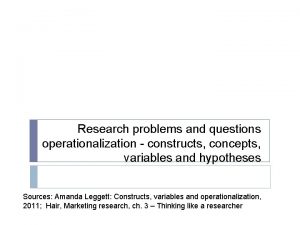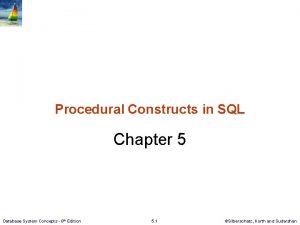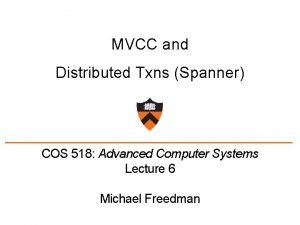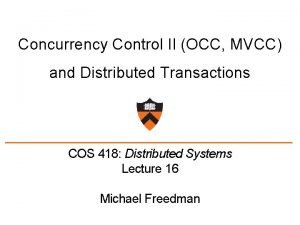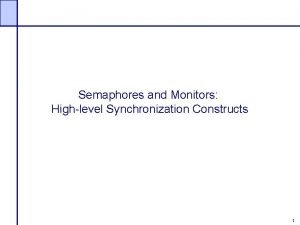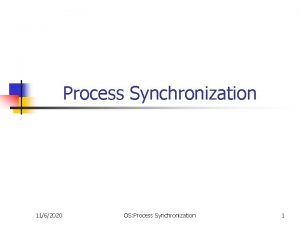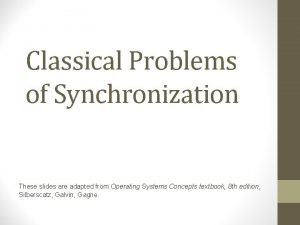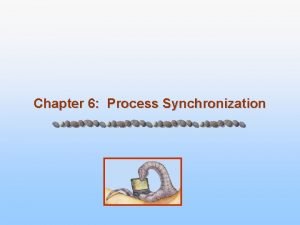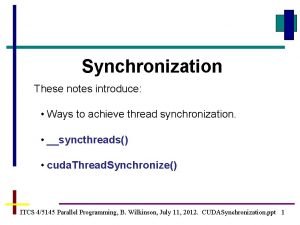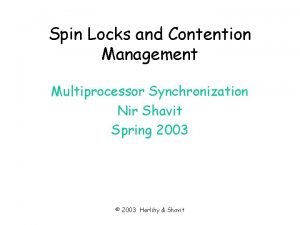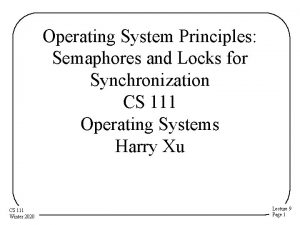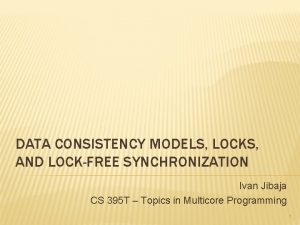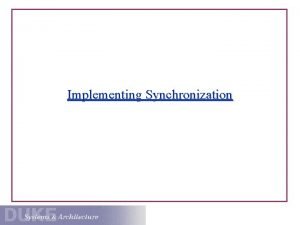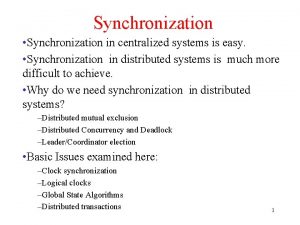Synchronization Constructs Critical Atomic and Locks Synchronization Motivation




![Critical Section: Syntax #pragma omp critical [name] structured block structured_block Critical section • No Critical Section: Syntax #pragma omp critical [name] structured block structured_block Critical section • No](https://slidetodoc.com/presentation_image_h/11a9b8c220c2f86bd95544b62ccb14d2/image-5.jpg)



























![Prefix Sum Problem • Given array A[0. . N-1], produce B[N], such that B[k] Prefix Sum Problem • Given array A[0. . N-1], produce B[N], such that B[k]](https://slidetodoc.com/presentation_image_h/11a9b8c220c2f86bd95544b62ccb14d2/image-33.jpg)




![… #pragma omp parallel for(i=0; i<n; i++){B[i]=A[i]; } int d=1; while(d<n) // this loop … #pragma omp parallel for(i=0; i<n; i++){B[i]=A[i]; } int d=1; while(d<n) // this loop](https://slidetodoc.com/presentation_image_h/11a9b8c220c2f86bd95544b62ccb14d2/image-38.jpg)




![Id-1 sums sum + . . . Thread 0 sums[id-1] Threadid-1 my. Begi. N Id-1 sums sum + . . . Thread 0 sums[id-1] Threadid-1 my. Begi. N](https://slidetodoc.com/presentation_image_h/11a9b8c220c2f86bd95544b62ccb14d2/image-43.jpg)




![… #pragma omp parallel for(i=0; i<n; i++){B[i]=A[i]; } int d=1; while(d<n) // this loop … #pragma omp parallel for(i=0; i<n; i++){B[i]=A[i]; } int d=1; while(d<n) // this loop](https://slidetodoc.com/presentation_image_h/11a9b8c220c2f86bd95544b62ccb14d2/image-48.jpg)




![Id-1 sums sum + . . . Thread 0 sums[id-1] Threadid-1 my. Begi. N Id-1 sums sum + . . . Thread 0 sums[id-1] Threadid-1 my. Begi. N](https://slidetodoc.com/presentation_image_h/11a9b8c220c2f86bd95544b62ccb14d2/image-53.jpg)

- Slides: 54

Synchronization Constructs Critical, Atomic, and Locks

Synchronization – Motivation • Different threads need to coordinate with each other in a parallel program • They communicate by writing and reading to the same shared variables • But they may step on each other’s toes • E. g. , simultaneously trying to write to the same variable • Also, sometimes we need to signal from one thread to the other • Signaling, for example, that some value is ready for the other thread to use L. V. Kale 2

Types of Synchronization • Concurrent access to shared data may result in data inconsistency – mechanism required to maintain data consistency: mutual exclusion • Sometimes code sections executed by different threads need to be sequenced in some particular order: event synchronization • From one thread to the others • Wait for all threads to complete some section of code before continuing on • This is called a barrier L. V. Kale 3

Mutual Exclusion • Mechanisms for ensuring the consistency of data that is accessed concurrently by several threads • Critical directive • Atomic directive • Library lock routines L. V. Kale 4
![Critical Section Syntax pragma omp critical name structured block structuredblock Critical section No Critical Section: Syntax #pragma omp critical [name] structured block structured_block Critical section • No](https://slidetodoc.com/presentation_image_h/11a9b8c220c2f86bd95544b62ccb14d2/image-5.jpg)
Critical Section: Syntax #pragma omp critical [name] structured block structured_block Critical section • No other thread is allowed to execute any code inside any critical section in the program if one thread is inside it • Other threads, if they encounter this directive, are made to wait, and only one of them will proceed into the critical section once thread inside leaves • The critical sections may be in many places in the code • If you add a name, then the restriction applies only to those sections that share the name L. V. Kale 5

Global vs. Named Critical Sections • Access to unnamed critical sections is synchronized with accesses to all critical sections in the program: global lock • To change the global lock behavior use the optional name parameter – access to a named critical section is synchronized only with other accesses to critical sections with the same name L. V. Kale 6

… … … #pragma omp critical { S 1 } … … #pragma omp critical sec 1 { S 1 } … #pragma omp critical { S 2} #pragma omp critical sec 2 { S 2} … … #pragma omp critical { S 3} #pragma omp critical sec 2 { S 3} At most one thread can be inside any of S 2 or S 3, and separately, another thread can be inside S 1 Only one thread can be inside any of S 1, S 2, or S 3 L. V. Kale 7

Critical Section Example cur_max = MINUS_INFINITY; #pragma omp parallel for(i=0; i<n; i++){ … if (a[i] > cur_max) cur_max = a[i]; … } L. V. Kale 8

Critical Section Example cur_max = MINUS_INFINITY; #pragma omp parallel for(i=0; i<n; i++){ … #pragma omp critical { if (a[i] > cur_max) cur_max = a[i]; } … } L. V. Kale 9

Critical Section Example cur_max = MINUS_INFINITY; max. Index = -1; #pragma omp parallel for(i=0; i<n; i++){ … #pragma omp critical { if (a[i] > cur_max) { cur_max = a[i]; max. Index = i} } … } L. V. Kale 10

Synchronization Constructs Critical, Atomic, and Locks

Atomic Directive • Critical sections are expensive (we will see later why) • But processors support fast single-variable updates as if they are in critical • Atomic directive provides access to those hardware capabilities when available • The body of an atomic directive is a single assignment statement • There are restrictions on x, expr, operator, and binop – these restrictions ensure that the assignment statement can be translated into an atomic sequence of machine instructions to read, modify, and write the memory location for x • Syntax: #pragma omp atomic <Restricted Statement form> Restricted statement form can be one of : x++; ++x; x--; --x; x binop = expr L. V. Kale binop: binary operator, such as +, 12

Variants of Atomic Directive • Many other variants of atomic are supported • They typically correspond to what the hardware can support as atomic operations • I. e. , an atomic operation completes before another atomic operation can start on the same variable (no interleaving) • We will cover only one variant defined by the capture clause L. V. Kale 13

Atomic Directive with the capture Clause • We want to atomically change a variable and “capture” its old (or new) value into another variable • Syntax: two forms are allowed #pragma omp atomic capture <Restricted expression statement> #pragma omp atomic capture <Restricted Structured Block> <Restricted expression statement > can be one of : v= x++; v = ++x; v = x--; v = --x; v = x binop = expr ; etc… Restricted Structured block can be: { v = x; x binop = expr} {x binop = expr; v =x} etc… For additional forms see Open. MP 4. 5 Standard For a particular compiler see: https: //software. intel. com/en-us/node/524509 L. V. Kale 14

Atomic and Critical #pragma omp parallel private(B) { y = compute(…); #pragma omp atomic x = x + y; } #pragma omp parallel private(B) { y = compute(…); #pragma omp critical { These two formulations are equivalent But the one with atomic is more efficient x = x + y; } } L. V. Kale 15

Library Lock routines • Routines to: • In the following, plock is a pointer to a variable of type omp_lock_t • Create a lock • omp_init_lock(plock) • Acquire a lock, waiting until it becomes available if necessary • omp_set_lock(plock) • Release a lock, resuming a waiting thread, if one exists • omp_unset_lock(plock) • Try and acquire a lock but return instead of waiting if not available • omp_test_lock(plock)(returns true if lock acquired) • Destroy a lock • omp_destroy_lock(plock) L. V. Kale 16

Library Lock Routines • Locks are the most flexible of the mutual exclusion primitives because there are no restrictions on where they can be placed • The previous routines don’t support nested acquires – deadlock if tried!! – a separate set of routines exist to allow nesting • I. e. With nesting, the same thread may acquire the lock multiple times, • Each time a count is incremented, and unlock decrements the count • Only when the count reaches back to 0, can other threads lock the same variable L. V. Kale 17

Mutual Exclusion Features • Apply to critical, atomic as well as library routines: • NO fairness guarantee • Guarantee of progress • Careful when using multiple locks – lots of chances for deadlock • Deadlocks: when a bunch of threads are waiting for each other in a circular fashion • Waits arise from locks held by others • Thread 1 locks A, requests B, while Thread 2 locks B, requests A • More generally: a circular wait: thread 1 waiting for thread 2, which waits for thread 3, which waits for thread 1 L. V. Kale 18

Case Study: Finding Primes

Example: List of Primes • Consider the problem of finding the first million prime numbers • We want to output an array containing the first million primes x = 3; j = 1; primes[0] = 2; while(j < 1000000){ if(is. Prime(x)){ Sequential Code: primes[j] = x; j++; } x = x + 2; } • Note that parallel for requires that the loop bounds need to be known before the loop starts • So, how can we parallelize this? L. V. Kale 20

Ideas for Parallelizing Primes. List • We can have each thread explore the next unexplored odd integer beginning with 3 x = 3; j = 1; primes[0] = 2; while(j < 1000000){ • Both x and j need to be if(is. Prime(x)){ primes[j] = x; protected because multiple threads want to read and write j++; } them x = x + 2; } • We can use locks or atomic variables for this purpose L. V. Kale 21

Version 1: Parallelizing Primes. List • We protect writes to j and x using atomic • Note that between the time a int x, j; x = 3; j = 1; primes[0] = 2; thread starts testing for x and #pragma omp parallel the time it increments x, x may while(j < 1000000){ have been changed by other if(is. Prime(x)){ primes[j] = x; threads #pragma omp atomic • So, after finishing testing 3, a thread may start working on testing 21, if other threads have already taken the number in between j++; } #pragma omp atomic x = x + 2; } Does this work? L. V. Kale 22

Version 1: Parallelizing Primes. List • The problem is between the time we test the primality of a number (x), and the time that it executes the assignment statement, some other thread might have changed the value of x • Also, two different threads may try to assign with the same value of j int x, j; x = 3; j = 1; primes[0] = 2; #pragma omp parallel while(j < 1000000){ if(is. Prime(x)){ primes[j] = x; #pragma omp atomic j++; } #pragma omp atomic x = x + 2; } Does this work? L. V. Kale 23

Version 2: Parallelizing Primes. List • A thread saves the current value of x and increases it by 2 in a single critical section • int x, j, my. X, k; x = 3; j = 0; primes[0] = 2; • No other thread can interfere #pragma omp parallel private(my. X, k) while(j < 1000000){ A thread atomically increments j but saves the new #pragma omp atomic capture value in its private variable k { my. X = x; x = x + 2; } if(is. Prime(my. X)){ #pragma omp atomic capture k = j++; primes[k] = my. X; } } Does this work? L. V. Kale 24

Version 2: Parallelizing Primes. List • This almost works • What are the problems? • Is the primes array sorted? • No, although it is almost sorted • Some threads might run ahead • How do we stop after the first one million primes? • While one thread is working on testing the millionth prime, another thread might finish testing the next prime and add it to the list int x, j, my. X, k; x = 3; j = 0; primes[0] = 2; #pragma omp parallel private(my. X, k) while(j < 1000000){ #pragma omp atomic capture { my. X = x; x = x + 2; } if(is. Prime(my. X)){ #pragma omp atomic capture k = j++; primes[k] = my. X; } } Fixing this is left as an exercise for you L. V. Kale 25

Parallelizing Primes. List: Ideas for Fixes • Let the loop go further for a few more iterations • How many? int x, j, my. X, k; • Maybe j < 1000000 + num. Threads? x = 3; j = 0; primes[0] = 2; • Sort the array at the end? • Too expensive • And it’s mostly sorted #pragma omp parallel private(my. X, k) while(j < 1000000){ #pragma omp atomic capture { my. X = x; x = x + 2; } if(is. Prime(my. X)){ #pragma omp atomic capture k = j++; primes[k] = my. X; } } L. V. Kale 26

Additional Coordination Constructs Barrier, Single, and Master Directives

Parallel Sections • Provide another way of creating a team of threads • In addition to construct parallel or parallel for • From the Openmp 4. 5 standard: • Independent different pieces of code assigned to different threads • (BTW: openmp standard is the (semi-)final arbiter • http: //www. openmp. org/specifications/ • Final arbiter is of course your compiler … hopefully it implements the latest standard. . . check always L. V. Kale 28

barrier Construct: Making Everyone Wait • This can be thought of as an event synchronization construct #pragma omp barrier • No thread can pass the barrier directive unless all threads (in the current team) have arrived at it • The programmer must take care to ensure all threads (in the team) encounter this statement or none of them do, for every execution of the program 29

The master Construct • In a parallel region, sometimes you want some action to be done only by the master thread • The parallel region may be a “parallel for” or a “parallel” construct, for example • Syntax: #pragma omp master structured_block • The master thread executes the structured_block, while • All the other threads past it • I. e. , they do not execute the structured_block nor do they wait for the master thread to execute it 30

The single Construct • Similar in spirit to the master construct • In a parallel region, sometimes you want some action to be done only by a single thread • It doesn't matter which thread executes it • Syntax: #pragma omp single structured_block • The first thread to arrive at this directive executes the structured_block, while • All the other threads past it • I. e. , they do not execute the structured_block nor do they wait for execution of this structured block by the first thread 31

Example: Prefix Sum Recursive Doubling with Barriers
![Prefix Sum Problem Given array A0 N1 produce BN such that Bk Prefix Sum Problem • Given array A[0. . N-1], produce B[N], such that B[k]](https://slidetodoc.com/presentation_image_h/11a9b8c220c2f86bd95544b62ccb14d2/image-33.jpg)
Prefix Sum Problem • Given array A[0. . N-1], produce B[N], such that B[k] is the sum of all elements of A up to A[k] 0 A 3 1 2 3 4 5 6 7 1 4 2 5 2 7 4 + + 15 17 24 28 + B 3 4 8 10 B[3] is the sum of A[0], A[1], A[2], A[3] But B[3] can also be calculated as B[2]+ A[3] L. V. Kale 33

Prefix Sum: A good Sequential Algorithm • Data dependency from iteration to iteration • How can this be parallelized at all? B[0] = A[0]; for (i=1; i<N; i++) B[i] = B[i-1] + A[i]; • It looks like the problem is inherently sequential, but theoreticians came up with a beautiful algorithm called recursive doubling or just parallel prefix L. V. Kale 34

Parallel Prefix: Recursive Doubling 0 1 2 3 4 5 6 7 5 3 7 2 1 3 1 N Data Items P Processors 2 N=P 5 8 10 9 3 4 4 3 Log P Phases P additions in each phase 5 8 15 17 13 13 7 7 5 8 15 17 18 21 22 24 P log P operations Completes in O(log. P) time L. V. Kale 35

Open. MP Formulation for Parallel Prefix • We don’t have n processors • I. e. , the number of threads will be much smaller than the size of the data array • So, we will simulate n processors using p threads • Notice that each phase of the computation must finish before the next phase of the computation starts • We will use Open. MP’s barrier directive for that • Basic description of actions in each phase with distance d • Every “processor” i adds its value to the value held by a processor distance d away • Simulation: B[i+d] += B[i], but you have to be careful to avoid dependencies • I. e. , copy B[i] into a temporary variable at i+d, say C[i+d] and then add C[i] to B[i] for every i • Note d doubles in every phase L. V. Kale 36

Parallel Prefix: Recursive Doubling 0 1 2 3 4 5 6 7 5 3 7 2 1 3 1 2 B - 5 3 7 2 1 3 1 C 5 8 10 9 3 4 4 3 B L. V. Kale 38
![pragma omp parallel fori0 in iBiAi int d1 whiledn this loop … #pragma omp parallel for(i=0; i<n; i++){B[i]=A[i]; } int d=1; while(d<n) // this loop](https://slidetodoc.com/presentation_image_h/11a9b8c220c2f86bd95544b62ccb14d2/image-38.jpg)
… #pragma omp parallel for(i=0; i<n; i++){B[i]=A[i]; } int d=1; while(d<n) // this loop will run for lg n steps { int i; #pragma omp parallel for(i=d; i<n; i++)C[i]=B[i-d]; #pragma omp parallel for(i=d; i<n; i++)B[i]+=C[i]; Initialize B with values from A C[k] temporarily stores the value that we want to add to B[k] d*=2; } … 39

Critique of Prefix Algorithm 1 • The sequential algorithm had n additions • But the parallel algorithm is doing a total of n*(log n) additions • Although they are parallelized by p threads • This is an example of an algorithm that is not “work efficient” • It uses log n barriers, which are expensive operations • Maybe a thread oriented approach will avoid the log n factors L. V. Kale 40

Prefix Sum Algorithm 2: A Thread Oriented Approach • L. V. Kale 41

Thread 0 . . . Threadid-1 my. Begi. N Threadid my. En. D 42

Prefix Sum Algorithm 2: A Thread Oriented Approach • L. V. Kale 43
![Id1 sums sum Thread 0 sumsid1 Threadid1 my Begi N Id-1 sums sum + . . . Thread 0 sums[id-1] Threadid-1 my. Begi. N](https://slidetodoc.com/presentation_image_h/11a9b8c220c2f86bd95544b62ccb14d2/image-43.jpg)
Id-1 sums sum + . . . Thread 0 sums[id-1] Threadid-1 my. Begi. N Threadid my. En. D 44

… omp_set_num_threads(p); #pragma omp parallel { int id=omp_get_thread_num(); int my. Begi. N = (n*id)/p; int my. En. D = min( (n*id+1)/p, n); int sum=0; for(int i=my. Begi. N; i<my. En. D; i++) sum+=B[i]; sums[id]=sum; #pragma omp barrier #pragma omp single { for(int i=1; i<p; i++) sums[i]+=sums[i-1]; } if(id>0)B[my. Begi. N]+= sums[id-1] for(int i=my. Begi. N+1; i<my. En. D/p; i++) for(int i=my. Begi. N+1; i<myend/p; i++) B[i]+=B[i-1]; } } } Form Local sum • Calculate Prefix sum of size p • Sums [id] now contains the sum of values of all previous threads’ ranges • This can be done in parallel but it’s not worth it Complete the Prefix sum 46

Example: Prefix Sum Recursive Doubling with Barriers: Algorithm 2

Prefix Sum: A good Sequential Algorithm • Data dependency from iteration to iteration • How can this be parallelized at all? B[0] = A[0]; for (i=1; i<N; i++) B[i] = B[i-1] + A[i]; • It looks like the problem is inherently sequential, but theoreticians came up with a beautiful algorithm called recursive doubling or just parallel prefix L. V. Kale 48

Parallel Prefix: Recursive Doubling 0 1 2 3 4 5 6 7 5 3 7 2 1 3 1 N Data Items P Processors 2 N=P 5 8 10 9 3 4 4 3 Log P Phases P additions in each phase 5 8 15 17 13 13 7 7 5 8 15 17 18 21 22 24 P log P operations Completes in O(log. P) time L. V. Kale 49
![pragma omp parallel fori0 in iBiAi int d1 whiledn this loop … #pragma omp parallel for(i=0; i<n; i++){B[i]=A[i]; } int d=1; while(d<n) // this loop](https://slidetodoc.com/presentation_image_h/11a9b8c220c2f86bd95544b62ccb14d2/image-48.jpg)
… #pragma omp parallel for(i=0; i<n; i++){B[i]=A[i]; } int d=1; while(d<n) // this loop will run for lg n steps { int i; #pragma omp parallel for(i=d; i<n; i++)C[i]=B[i-d]; #pragma omp parallel for(i=d; i<n; i++)B[i]+=C[i]; Initialize B with values from A C[k] temporarily stores the value that we want to add to B[k] d*=2; } … 50

Critique of Prefix Algorithm 1 • The sequential algorithm had n additions • But the parallel algorithm is doing a total of n*(log n) additions • Although they are parallelized by p threads • This is an example of an algorithm that is not “work efficient” • It uses log n barriers, which are expensive operations • Maybe a thread oriented approach will avoid the log n factors L. V. Kale 51

Prefix Sum Algorithm 2: A Thread Oriented Approach • L. V. Kale 52

Thread 0 . . . Threadid-1 my. Begi. N Threadid my. En. D 53

Prefix Sum Algorithm 2: A Thread Oriented Approach • L. V. Kale 54
![Id1 sums sum Thread 0 sumsid1 Threadid1 my Begi N Id-1 sums sum + . . . Thread 0 sums[id-1] Threadid-1 my. Begi. N](https://slidetodoc.com/presentation_image_h/11a9b8c220c2f86bd95544b62ccb14d2/image-53.jpg)
Id-1 sums sum + . . . Thread 0 sums[id-1] Threadid-1 my. Begi. N Threadid my. En. D 55

… omp_set_num_threads(p); #pragma omp parallel { int id=omp_get_thread_num(); int my. Begi. N = (n*id)/p; int my. En. D = min( (n*(id+1))/p, n); int sum=0; for(int i=my. Begi. N; i<my. En. D; i++) sum+=B[i]; sums[id]=sum; #pragma omp barrier #pragma omp single { for(int i=1; i<p; i++) sums[i]+=sums[i-1]; } #pragma omp barrier if(id>0)B[my. Begi. N]+= sums[id-1] for(int i=my. Begi. N+1; i<my. En. D/p; i++) for(int i=my. Begi. N+1; i<myend/p; i++) for(int i=my. Begi. N+1; i<my. En. D; i++) B[i]+=B[i-1]; } } } Form Local sum • Calculate Prefix sum of size p • Sums [id] now contains the sum of values of all previous threads’ ranges • This can be done in parallel but it’s not worth it Complete the Prefix sum 57
 Critical semi critical and non critical instruments
Critical semi critical and non critical instruments Spaulding classification
Spaulding classification Relative formula mass of hcl
Relative formula mass of hcl Mass of oxygen
Mass of oxygen Atomic
Atomic Operationalized research question examples
Operationalized research question examples Sending and receiving signals are special constructs of
Sending and receiving signals are special constructs of Primary resistance and retention form
Primary resistance and retention form Secondary resistance and retention forms
Secondary resistance and retention forms Periodic trends in properties of elements
Periodic trends in properties of elements Atomic radius vs ionic radius
Atomic radius vs ionic radius Atomic number vs atomic radius
Atomic number vs atomic radius Non synthesizable constructs in verilog
Non synthesizable constructs in verilog Procedural constructs
Procedural constructs Php language constructs
Php language constructs The calvin cycle constructs
The calvin cycle constructs Control flow constructs
Control flow constructs Cfir constructs
Cfir constructs Abstract data type
Abstract data type Atoms escape room digital locks answers
Atoms escape room digital locks answers Forcible entry magnetic locks
Forcible entry magnetic locks Proximal ditch technique
Proximal ditch technique Acsys locks
Acsys locks Advisory lock postgres
Advisory lock postgres Advantages of two phase locking protocol in dbms
Advantages of two phase locking protocol in dbms Forcible entry magnetic locks
Forcible entry magnetic locks Proper term for channel locks
Proper term for channel locks Timemasters locks
Timemasters locks Concurrency control in distributed transactions
Concurrency control in distributed transactions Slidetodoc.com
Slidetodoc.com Synchronization algorithms and concurrent programming
Synchronization algorithms and concurrent programming Fast clock to slow clock synchronization
Fast clock to slow clock synchronization One fundamental high level synchronization construct is
One fundamental high level synchronization construct is Process synchronization in os
Process synchronization in os Tally data synchronization
Tally data synchronization Multiprocessor synchronization
Multiprocessor synchronization Lean synchronization
Lean synchronization Soft-reconfiguration inbound
Soft-reconfiguration inbound Lock free synchronization
Lock free synchronization Classic problems of synchronization
Classic problems of synchronization Synchronization tool in os
Synchronization tool in os Process synchronization in os
Process synchronization in os Basic synchronization principles
Basic synchronization principles Windchill basics
Windchill basics Cuda synchronize threads
Cuda synchronize threads Process synchronization means
Process synchronization means Time frequency domain
Time frequency domain Pthread synchronization
Pthread synchronization Posix shared memory synchronization
Posix shared memory synchronization Synchronization primitives c#
Synchronization primitives c# Process synchronization definition
Process synchronization definition Linux kernel synchronization
Linux kernel synchronization Kernel synchronization in linux
Kernel synchronization in linux Synchronization in distributed systems
Synchronization in distributed systems Wait free synchronization
Wait free synchronization





